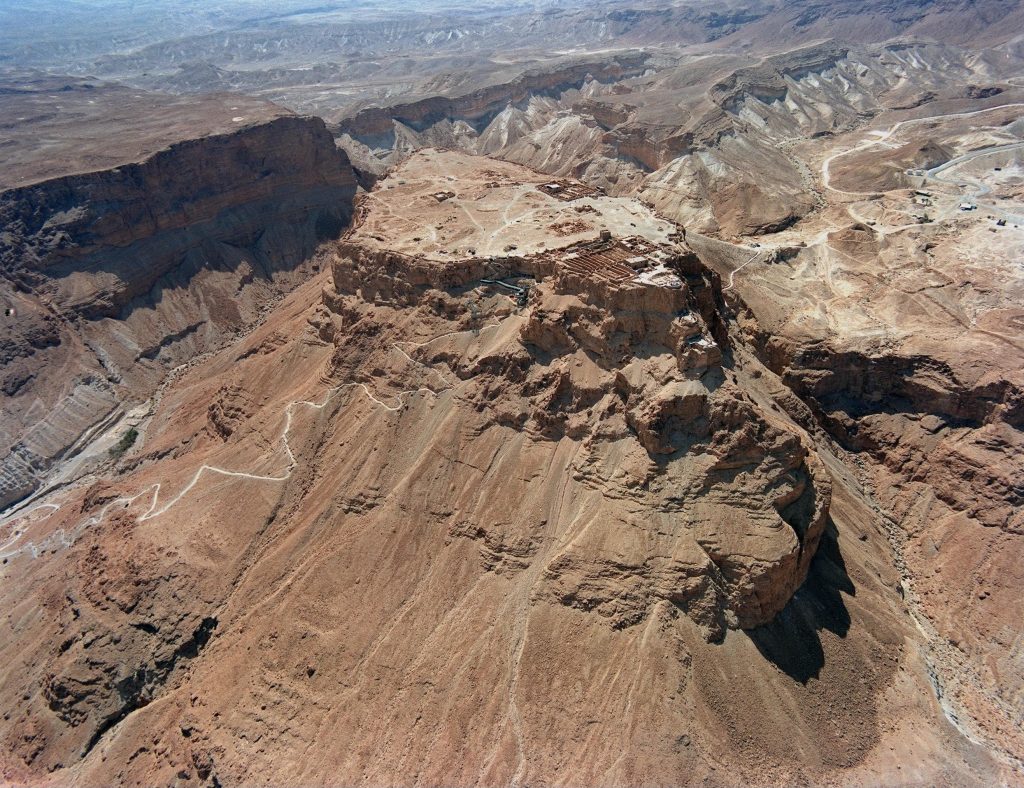Masada was an impressive fortress built upon a plateau to protect Jewish Zealots and refugees from the Romans. The Jews wisely chose this location because of its natural defenses against invaders. They imagined it would be impossible for anyone to besiege the city; the treacherous terrain and great outer wall surrounding Masada surely would protect it. Unfortunately, the Jews underestimated the Roman army.

Masada appeared to be the perfect fortress. Its four vertical sides made it nearly impossible to invade. The largest wall on the eastern side is one hundred forty meters above the desert floor, roughly half the size of the Eiffel Tower. From the east, there is a dangerous zig-zagging trail called the serpent’s path. The western side wall is eighty meters above the desert floor, as tall as the Statue of Liberty. The inhabitants took the extra precaution and built two walls on the perimeter of the plateau about 1400 meters long and six meters tall. The outer wall was 1.4 meters thick and the inner was 1 meter thick. Between the inner and outer wall, there was an empty space. During an invasion they planned to fill the gap with stone, wood, and dirt to strengthen the wall; until then it was used for storage. There were also twenty-meter-tall towers strategically spaced out throughout Masada for defensive reasons.1
The defenders were aware that if one were to attack, the first action the enemy would take would be to stop the water supply. Anticipating that possibility, the defenders built twelve cisterns to hold the water inside the fortress. Along the western slopes they had enough water stored to fill sixteen Olympic pools. It was very forward thinking of the Jews to do this. They also had many food storehouses toward the north. They kept grain, oils, corn, wine, dates, along with other foods. Thanks to the dry climate, storing the food was not a problem. In case they were to run low, the flat land would be ideal to grow additional food. Remains of the wall, tower, cisterns, food storage buildings, and other structures are still visible today.1

Unfortunately, these precautions were no match for the Roman army. In 73 C.E., Flavius Silva marched the Roman army and other troops totaling about 10,000 soldiers south to conquer Masada. Waiting on top of Masada were the 1,000 men (Jewish refugees and Zealots) willing to defend their safe haven. The Romans were aware it would take a significant amount of time to destroy Masada, so they set up camp and had Jewish war prisoners bring a constant supply of food and water. They first stopped up the aqueducts and diverted them for their own use. Next, they constructed a wall around Masada to prevent the inhabitants from escaping, and to cut them off from the outside world, a classic Roman war operation. The wall was three meters high and 3.2 kilometers long, and enforced by eight camps with many other guards posted. This impressive mechanism was built in a matter of days and can still be seen today.1

The Romans knew this would not be a quick victory; they would have to overthrow Masada by force. They came to the conclusion that the only way to reach the top of Masada was by making the steep side into a gradual incline. To do this, they took advantage of a natural spur called the white rock on the western side. It was nearly two hundred meters from the top of Masada to the edge of the natural gulf. The ramp to the top was built at a twenty degree incline. It took months to build the massive ramp. Every day, the inhabitants of Masada would wake up to see the enemy growing closer and closer, with no way for them to escape. As the Romans got close to the top, they became more vulnerable to the defenders. The Jews at the top could now shoot arrows and defend themselves against the Romans. As a result, the Romans had the Jewish war prisoners shield them so that they could shoot back. Within two months, the great ramp was complete. It was two hundred twenty meters long, and archaeologists assume it weighed as much as one and a half empire state buildings.4
The Romans attacked Masada with their siege towers. They rolled the massive towers up the man-made ramp to overthrow Masada. The inhabitants tried to fight back, shooting arrows at the towers and trying to destroy it with fire.4 The day before the final attack, the Romans carefully planned how they would conquer Masada. Early that morning, they charged up the ramp, and over the walls. To their surprise, they were not met with a fight. Instead, they encountered thousands of dead bodies. The few remaining women and children explained to them what had happened. The Jews knew they did not stand a chance against the Roman army of 10,000. They decided it would be better to die than to be conquered. Since Judaism does not allow suicide, they came to the conclusion they would have to kill each other. The men first killed the children and women; then they cast lots to decide who would be killed first, and who would have to be the last to commit suicide. It is ironic how they ignored the sixth commandment not to murder, but decided to alter its meaning to mean not to murder yourself. Despite the confusion, they ultimately chose death over slavery.6
- Encyclopedia Judea, 2007, s.v. “Masada,” by Michael Berenbaum. ↵
- Encyclopedia Judea, 2007, s.v. “Masada,” by Michael Berenbaum. ↵
- Encyclopedia Judea, 2007, s.v. “Masada,” by Michael Berenbaum. ↵
- The Greenhaven Encyclopedia of the Ancient World, 2002, s.v. “Siege of Masada,” by Don Nardo. ↵
- The Greenhaven Encyclopedia of the Ancient World, 2002, s.v. “Siege of Masada,” by Don Nardo. ↵
- Encyclopedia of Death & Human Experiences, 2009, s.v. “Mass Suicide,” by Clifton D. Bryant. ↵



86 comments
Joshua Breard
How far will you go to stand by your religious beliefs? The Jewish refugees that were residents of Masada were so steadfast on their beliefs that they believed that it was better to die than to be conquered by the Roman army. Masada was like the Titanic, a giant that would eventually reach a downfall. Once the refugees saw the downfall approaching, they made the judgement call on either living as a prisoner to eventually die or to die being refugee with a strong religious belief.
Nahim Rancharan
I must say that this was one of my favorite read so far! I especially enjoyed reading about the advanced military tactics about two of the world’s oldest ethnic groups, the Jews and the Romans. This article kept wanting me to read more and more. I like how you brought in the circumstances of the situations as well as the ingenious military tactics of both groups before and during the attack. Additionally, i found it interesting to see the sustainable ideas and technologies that the Jews had employed given their geographical location as well as how their beliefs and culture resulted in an act that earned them a spot as one of the world’s most remembered evens in history. I enjoyed every word of the article. Excellent work!
Samuel Sanchez
This was a good article to read for a second time. You did really good job explaining how the city was layed out. Kind of sad to see that the Romans pushed the Jews to the extent of suicide. It is amazing how much effort the Romans just to control the Jews. You did a really great job with all the information and it really pulled me in. Keep up the great work.
Irene Astran
I really appreciated this article when I read it earlier in the semester. I have to say as I look at it now I have a greater appreciation for the pictures that you complimented this article with. The first one gives the reader a great feel for what life looked like inside of the walls, the second truly demonstrates the height of the walls, and the third, which I feel is the most important article illustrates the work that the Romans needed to put into their attack in order to overthrow Masada.
Erick Martinez
This was a very well written article on a great topic Jennifer. All the hard work you put into your research shows throughout the article. You presented numerous useful facts while you told the tragic story of the city of Masada. The majority of this information was new to me so I would like to thank you for taking the time out of your day to teach me something new.
Briana Bustamante
Such an interesting article and topic. I had no idea that there was a mass suicide. It’s so sad how the Romans drove the Jews to the extent of suicide. I can not even begin to imagine what I would have done if I was living during this time. You did a great job describing the layout of the city. I can see who your article was nominated for, best in “World History” and “Captivating and Engaging”. Over all, great work!
Tyler Sleeter
Really great article with lots of information. I had no idea that massive size of the walls and ramps involved in this siege or that it took so long to complete. It was interesting to read about how the Jewish people fortified their walls and tried to fight off the Romans from attack. I was surprised to learn that the Romans spent so much time trying take the city in order to further control the Jewish population. This article was a great read and well written.
Gabriela Medrano
The Roman army was well known for their ability to conquer and at a rapid pace in massive areas. It is no surprise what they did to the Jews in Masada. What was surprising was how the Jews reacted to the coming of the Romans! It was a great act of faith and given their circumstances it was probably the only way they felt was an escape to being enslaved. It is truly shocking! Enjoyed the article, good read, and interesting topic. well done!
Lianna Ybarra
It is interesting that the Jews decided to take each other’s lives instead of killing themselves. I wonder how the last few women and children though were still alive if they had all decided to kill each other. To think of all the time and thought they put into building this city, thinking nothing would ever happen to them and then having to kill themselves is sad.
Aaron Jaramillo
This was a great article Jennifer. I did not have any idea that the the city of Masada existed. Its exciting to me to learn about new thing all around the world. It amazes me that the Jews choose to take their own life than to be slaves of the romans. I wonder who convinced all the Jews to go against the sixth commandment.